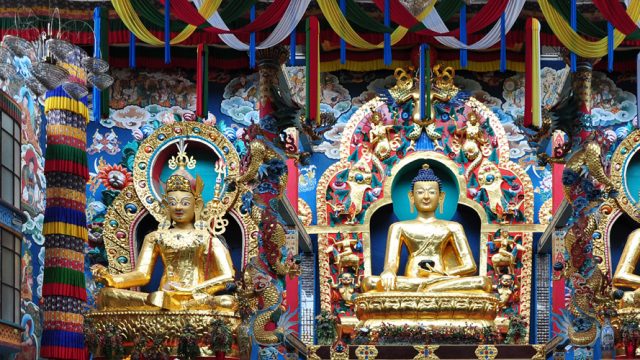Overlooking the Tashi-Lhunpo Monastery and Monastic University, my grandparents’ abode in Bylakuppe, Karnataka, has seen me wake to the sound of monks chanting at the crack of dawn, everyday. This monastery, the seat of the 11th Panchen Lama Rinpoche, originally established in Shigatse in Tibet, was re-established in Bylakuppe in 1972 and stands as an important marker of the preservation of Tibetan Buddhist culture in an area called New camp-Laxmipur, the oldest area inhabited by Tibetans in the region. Walking in through the gates of both the old and the new Tashi Lhunpo Monastery (the new monastery was completed a few years ago and is erected very close to the former monastery) I feel nothing but an almost prodigious gust of wind make the hair on my body stand and settle. During the metaphorical act of prostration, I’ve come to realise that it is not religion that demands this of people but the very knowledge of accepting the existence of something larger and valuing one’s own contribution as a miniscule part of it. Since childhood, I’ve marveled over the enormous idols of the Buddha in the monasteries of Bylakuppe, carefully placed and ornamented, beaming with a gold finish and clothed with the venerating kha-dha (scarf like garland) around the neck.
It is common to find many local Kannada inhabitants searching for a sense of calm and compassion in these monasteries, a place where they have felt comfortable and welcomed for decades. What the locals call Tibetan “camps”, lie smack in the middle of Bylakuppe. During my visits to this land of coconuts, carols and coffee, I make it a point to roll down my windows even before Google maps declares the name of the destination for these settlements immediately mark their presence as soon as one enters this town, with its unique display of Tibetan prayer flags tied around coconut trees.

There is a lot in store for those who want to satiate their hunger for spirituality with monasteries like the Sera Jey and the Sera Mey both located in close proximity of one another, owing to the Gelukpa school of Tibetan Buddhism. Suggesting the constancy of worship and service, one can find many such monasteries placed in almost every camp in Bylakuppe, welcoming multitudes of tourists and inhabitants alike. They say that nothing can compete with the power that women hold within them and this translates into the strong faith that people have in the Ani Gomba (Tibetan Nunnery) called The Ngagyur Tsogyal Shedrub Ling Nunnery. At a stone’s throw away stands the most visited and glorious Namdroling Monastery, popularly called The Golden Temple. An architectural wonder in itself with its long lineage of Nyinmapa Tibetan Buddhism, this monastery sees visitors throughout the year witnessing the glorious sight of glistening gold, housing golden statues of the Buddha Shakyamuni, the Buddha Amitayus and the Padmasambhava. Amidst the resonating sounds of gongs, chanting monks and chirping birds the Namdroling Monastery stands apart and establishes its presence by towering over the silver oak plantations of Bylakuppe.
The entire town of Bylakuppe can be treated as a pilgrimage site because of the absolute piousness that it surrounds itself with, in the form of its temples, churches, mosques and monasteries; its forever dancing coconut groves in the Carnatic winds and its people entranced with their own delight in coalescing cultures.
I have found immense fulfillment in witnessing my family’s everyday routine of conversing with the neighbors and house help in Kannada or watching the local shopkeepers and auto-vaalas huddle around mugs of Pheu-chaa (Tibetan butter tea), chatting away in a tongue that they have come to embrace as much as their own.

My Momola and Popola (grandmother and grandfather) have lived in Bylakuppe all their lives and during my annual visits, my sense of intrigue with this quaint little town has never left me. I often reminisce my first experience of riding in an auto with my grandfather and telling him how the seat was uncomfortable, to which the auto driver, a Kannada speaking anna politely responded with a gon-dha (I’m sorry) in Tibetan. The incident never ceases to remind me of the enthralling quality of Bylakuppe and its inhabitants. Hyphenated identities have always been a signature of such places because of the sheer vibrance and variety they house. Bylakuppe is a melting pot of different cultures, ethnicities, religious practices and languages. Its people breathe the same air and in this act of respiring, they acceptingly and affably inhale and exhale multiplicity. It is this lesser known “little Tibet” that makes one wonder about how cultures collide and create a heterogeneous space, while never giving up on their individualities. With its plethora of grand monasteries and monastic universities, there’s no turning back once you enter this holy haven.
The information
Featured monasteries in Bylakuppe:
Tashi Lhunpo Monastery
Sera Jey Monastery
Sera Mey Monastery
The Golden Temple (Namdroling Monastery)
Ngagyur Tsogyal Shedrub Ling Nunnery
Must Eat:
La-phing (pale noodles made of soya bean) found anywhere on the streets. This is Tibetan food on the go with a spicy twist with a tang.
Pheu-cha (butter tea) served in Potala House restaurant, Camp no.1, Bylakuppe
Getting there: There are multiple flights which fly directly to Bangalore, offered by Jet Airways, Indigo, Air India, to name a few.
You can catch a Volvo bus from the airport to Kushal Nagar, in Bylakuppe or choose to travel by the various cab services available at the airport. Prices range from ₹ 3500- 5000.




